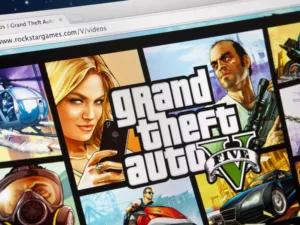The most financially successful video game in history is not free to play. It does not rely on nostalgia nor pander to critics. Its name? Grand Theft Auto V. Since 2013, this title has earned over $8 billion in revenue, surpassing every movie, album, and bestselling novel. Some might point to Dungeon Fighter Online with its $22 billion lifetime haul, or Fortnite, PUBG, and Honor of Kings, each raking in tens of billions through in-game purchases.
If we adjust for inflation, Space Invaders climbs to $31 billion. But these numbers blur under scrutiny. They span decades, hinge on regional popularity, and rely on free-to-play monetization or arcade quarters. GTA V did something else entirely. It built a cultural empire from a one-time purchase and sustained it with ruthless precision.
The Power Behind the Design
Rockstar Games had already established itself as a provocateur before GTA V. But with this release, it broke its own formula. Instead of one protagonist, players controlled three. Each came from a different class, different worldview, different set of compromises. Franklin wanted legitimacy, Michael wanted redemption, Trevor wanted nothing but chaos. Their stories intertwined without narrative fatigue. No mission felt like filler.
The city of Los Santos, modeled after Los Angeles, sprawled with grim detail. Its highways crawled with traffic, its neighborhoods shifted in tone, and its satire struck with clarity. Billboards mocked Silicon Valley. Radio stations parodied political extremism. You didn’t just play the game. You lived in it.
Strategic Timing and Sales Mastery
GTA V launched at the tail end of the PlayStation 3 and Xbox 360 cycle. Most developers were waiting for the next generation. Rockstar released it before the shift, seizing a massive user base. Then, it re-released the same game, enhanced, on PlayStation 4, Xbox One, PC, then later on PlayStation 5 and Xbox Series X.
Each version sold millions. Players bought it again for better graphics, for new features, for first-person mode. The game became a recurring purchase across time, a rare feat in a market that often forgets last year’s blockbuster. While other titles peaked and faded, GTA V continued its ascent.
The Engine of Recurring Revenue
The single-player mode sold the product. But GTA Online built the empire. Initially unstable, the online world matured into a universe of its own. Rockstar updated it constantly: heists, casinos, yachts, bunkers, weaponized vehicles, orbital cannons. Each update came free, but each required money, virtual money. Shark Cards, the in-game currency sold for real cash, became the backbone of the game’s economy.
Players could grind, or they could pay. Many paid. Businesses built in the game generated revenue in cycles. Players returned daily. Rockstar learned from player behavior and adjusted prices, pacing, and difficulty to maximize engagement without causing revolt. The line between game and platform blurred.
Cultural Echoes and Media Envy
GTA V did not merely entertain. It observed and recorded. It delivered a more accurate depiction of modern Western life than many films or books. Greed, surveillance, social collapse, these themes ran through every mission, every offhand conversation, every radio commercial.
Television shows mirrored its characters. YouTube channels thrived on its chaos. Influencers made careers roleplaying within its servers. Rockstar spent little on traditional marketing because players kept the conversation alive.
By the time people began to search for “what game has made the most money,” the answer was already clear. It wasn’t just the most successful game. It was the most successful entertainment product of all time.
Lessons From the Long Game
Most studios would have rushed a sequel. Rockstar did not. It refused to dilute the brand. For over a decade, it allowed GTA V to mature. The decision cost them nothing and earned them billions. No trailers, no leaks, no false urgency.
Meanwhile, other companies mimicked the surface. They added microtransactions and open worlds but missed the depth. They pushed quantity over coherence. Rockstar’s discipline, its refusal to oversaturate, kept its game evergreen.
The game also proved that satire sells when it’s sharp, not safe. It mocked America but sold better there than anywhere else. It stripped the glamour off crime, then let players glamorize it anyway. It held contradictions without apology.
The Shape of Future Giants
The entertainment landscape has changed. One game now competes not with other games, but with entire platforms. It competes with Netflix, TikTok, and Spotify. It has taught studios to think in decades, not quarters.
New titles may one day earn more, but they will do so by studying the blueprint GTA V created. Its path combined narrative, platform strategy, behavioral economics, and cultural criticism. Few will manage to replicate it, but all will try.
A Legacy That Demands Attention
GTA V earned its billions by knowing its audience, trusting its design, and staying relentlessly relevant. It avoided gimmicks. It avoided repetition. It became a mirror, a joke, a heist, and a home.
It did not ask what players wanted. It showed them something better. That clarity, combined with nerve and vision, has made it the highest-grossing game in history. And that legacy, now embedded in pop culture and corporate playbooks alike, will remain unmatched for years.

